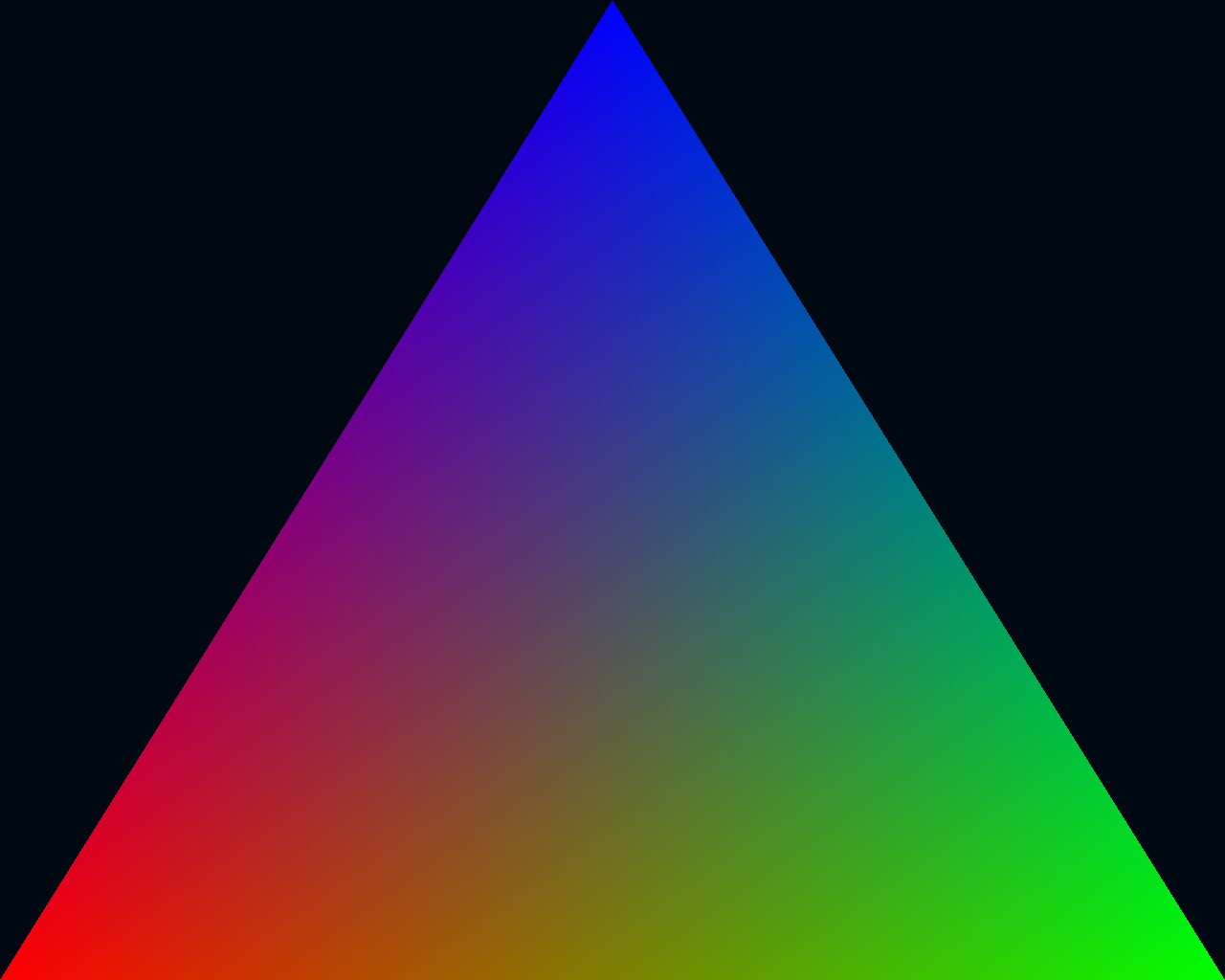How to use the canvas C API¶
This example shows how to write a standalone C app using only the canvas API, not the scene API. We'll render a triangle without using existing graphics, visuals, panels, and so on. We'll follow these steps:
- Creating a graphics with custom shaders,
- Creating a function callback for command buffer refill,
- Creating a vertex buffer manually.

// code from `examples/standalone/standalone_canvas.c`:
/*************************************************************************************************/
/* Example of a standalone application using the vklite API in a canvas. */
/* This script opens a live canvas with a triangle rendered on the GPU. */
/*************************************************************************************************/
/// Import the library public header.
#include <datoviz/datoviz.h>
// Objects we'll need in the refill callback.
// NOTE: Using static global variables in production code is bad practice.
static DvzBufferRegions vertex_buffer;
static DvzGraphics graphics;
static DvzBindings bindings;
// Refill callback. This function is called by the canvas whenever it needs to recreate its command
// buffers, for example when initializing the canvas, and when resizing it.
static void _triangle_refill(DvzCanvas* canvas, DvzEvent ev)
{
ASSERT(canvas != NULL);
// The callback is passed an event object with a list of command buffers to recreate. In
// this particular example, we just use a single command buffer.
ASSERT(ev.u.rf.cmd_count == 1);
DvzCommands* cmds = ev.u.rf.cmds[0];
// There is by default just one command buffer, linked to the render queue.
ASSERT(cmds->queue_idx == DVZ_DEFAULT_QUEUE_RENDER);
// This is the current swapchain image index for which we need to refill the command buffer.
// There is one command buffer per swapchain image, so whenever a command buffer refill is
// needed, this callback function is called three times for example, if using triple buffering.
uint32_t idx = ev.u.rf.img_idx;
// We begin recording the command buffer here.
dvz_cmd_begin(cmds, idx);
// We begin the default render pass.
dvz_cmd_begin_renderpass(cmds, idx, &canvas->renderpass, &canvas->framebuffers);
// We set the viewport to the entire framebuffer size.
dvz_cmd_viewport(cmds, idx, canvas->viewport.viewport);
// We bind the vertex buffer for the upcoming drawing command.
dvz_cmd_bind_vertex_buffer(cmds, idx, vertex_buffer, 0);
// We bind the graphics pipeline.
dvz_cmd_bind_graphics(cmds, idx, &graphics, &bindings, 0);
// We render 3 vertices (1 triangle).
dvz_cmd_draw(cmds, idx, 0, 3);
// End of the render pass and command buffer.
dvz_cmd_end_renderpass(cmds, idx);
dvz_cmd_end(cmds, idx);
}
// Entry point.
int main(int argc, char** argv)
{
// We create a singleton application with a GLFW backend.
DvzApp* app = dvz_app(DVZ_BACKEND_GLFW);
// We use the first detected GPU. The last argument is the GPU index.
DvzGpu* gpu = dvz_gpu_best(app);
// We create a new canvas with the size specified. The last argument is for optional flags.
DvzCanvas* canvas = dvz_canvas(gpu, 1024, 768, 0);
// Graphics pipeline.
{
// We create a new graphics pipeline.
graphics = dvz_graphics(gpu);
// We set the renderpass.
dvz_graphics_renderpass(&graphics, &canvas->renderpass, 0);
// We specify the primitive.
dvz_graphics_topology(&graphics, VK_PRIMITIVE_TOPOLOGY_TRIANGLE_LIST);
// We set the shaders.
dvz_graphics_shader(&graphics, VK_SHADER_STAGE_VERTEX_BIT, "triangle.vert.spv");
dvz_graphics_shader(&graphics, VK_SHADER_STAGE_FRAGMENT_BIT, "triangle.frag.spv");
// We specify the vertex structure size.
dvz_graphics_vertex_binding(&graphics, 0, sizeof(DvzVertex));
// We specify the two vertex attributes.
dvz_graphics_vertex_attr(
&graphics, 0, 0, VK_FORMAT_R32G32B32_SFLOAT, offsetof(DvzVertex, pos));
dvz_graphics_vertex_attr(
&graphics, 0, 1, VK_FORMAT_R8G8B8A8_UNORM, offsetof(DvzVertex, color));
// Once we've set up the graphics pipeline, we create it.
dvz_graphics_create(&graphics);
}
// We create the (empty) bindings: the shaders do not necessitate any uniform or
// texture in this example.
bindings = dvz_bindings(&graphics.slots, 1);
dvz_bindings_update(&bindings);
// Vertex data and GPU buffer.
DvzBuffer buffer = dvz_buffer(gpu);
{
// We create the GPU buffer holding the vertex data.
// NOTE: in real applications, once should use few, even a single large vertex buffer for
// all graphics pipelines in the application. Defining many small GPU buffers is bad
// practice.
// There will be three vertices for 1 triangle.
VkDeviceSize size = 3 * sizeof(DvzVertex);
dvz_buffer_size(&buffer, size);
// We declare that the buffer will be used as a vertex buffer.
dvz_buffer_usage(&buffer, VK_BUFFER_USAGE_VERTEX_BUFFER_BIT);
// The buffer should be accessible directly from the CPU in this example (bad practice in
// real applications).
dvz_buffer_memory(
&buffer, VK_MEMORY_PROPERTY_HOST_VISIBLE_BIT | VK_MEMORY_PROPERTY_HOST_COHERENT_BIT);
// Once set up, we create the GPU buffer.
dvz_buffer_create(&buffer);
// We define a view (buffer region) on the entire buffer.
vertex_buffer = dvz_buffer_regions(&buffer, 1, 0, size, 0);
// Define the vertex data.
// NOTE: in this example, we don't include the common.glsl shader and we use raw Vulkan
// shaders. So the Vulkan coordinate system is used, with the y axis going down.
DvzVertex data[3] = {
{{-1, +1, 0}, {255, 0, 0, 255}}, // bottom left, red
{{+1, +1, 0}, {0, 255, 0, 255}}, // bottom right, green
{{+0, -1, 0}, {0, 0, 255, 255}}, // top, blue
};
// We upload the data to the GPU vertex buffer.
dvz_buffer_regions_upload(&vertex_buffer, 0, data);
}
// We set the command buffer refill callback, the function that will be called whenever the
// canvas needs to refill its command buffers. The callback generates the GPU commands to draw
// the triangle.
dvz_event_callback(canvas, DVZ_EVENT_REFILL, 0, DVZ_EVENT_MODE_SYNC, _triangle_refill, NULL);
// We run the application. The last argument is the number of frames to run, or 0 for infinite
// loop (stop when escape is pressed or when the window is closed).
dvz_app_run(app, 0);
// We need to clean up all objects handled by Datoviz at the end.
dvz_graphics_destroy(&graphics);
dvz_buffer_destroy(&buffer);
dvz_app_destroy(app);
return 0;
}